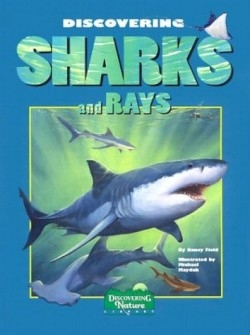Discovering Sharks and Rays
Sharks have had a bum rap. If they need a public relations spokesperson, however, they have one in this author. She explains that they are not as dangerous to people as movies and the media make them out to be. Despite their negative reputation as toothy predators, snatching bathers at public beaches, sharks are important to the health of the oceans and even to cancer research.
That’s the message of this nature activity book, packed with facts, tidbits, puzzles, pictures, stickers, and games. The fifty-four color stickers of sharks and rays alone demonstrate the incredible diversity of species. Less a story than a marine adventure, each page is crammed with information designed to help upper elementary students and middle-schoolers understand the importance of sharks and rays.
Rays are “winged sharks,” relatives of sharks, according to Field. Although not much space is dedicated to rays, which are more likely to be seen by beach-walkers in coastal waters than sharks, Field relates that there are more than 500 species of these members of the batoid family.
The author, who holds degrees in biology, science education, and wildlife biology, has been certified by the Wildlife Society as an associate wildlife biologist. She co-organized the first Earth Day in 1970; has written twelve interactive nature books for children; and has taught science at the junior high, senior high, and college levels. Her concern for sharks, often maligned and misunderstood sea creatures, is evident as she notes that demand for shark products is greater than supply. “Sharks are being overfished…People are more dangerous to sharks than sharks are to people,” she writes.
The illustrator has created artwork for several previous children’s science books, including A Drop Around the World, which won the 1998 Publisher’s Marketing Association Benjamin Franklin Silver Award in the Environment category. Here, his line drawings illustrate what happens below the surface if sharks are—or aren’t—around. Pages with color illustrations teem with life in a mangrove nursery or coral reef, displaying many species. Puzzles, games, and information on what marine biologists do add to the fun.
This activity book is part of a series from the Discovering Nature Library. Throughout, the somber message is clear to a generation that needs to hear it (and their parents): the Earth’s wildlife must be protected or even the shark will be on the endangered species list, and that will cause problems in the entire food chain. Meanwhile, there is plenty to enjoy while learning about them.
Reviewed by
Linda Salisbury
Disclosure: This article is not an endorsement, but a review. The publisher of this book provided free copies of the book to have their book reviewed by a professional reviewer. No fee was paid by the publisher for this review. Foreword Reviews only recommends books that we love. Foreword Magazine, Inc. is disclosing this in accordance with the Federal Trade Commission’s 16 CFR, Part 255.

